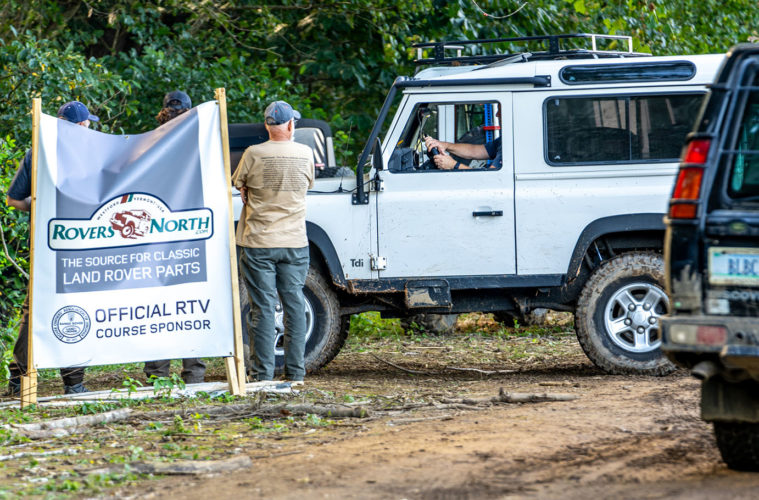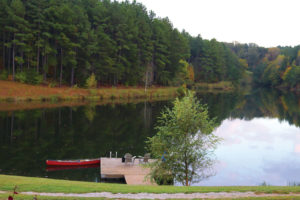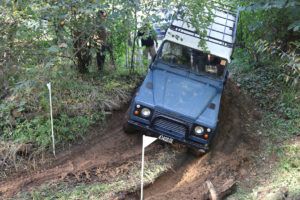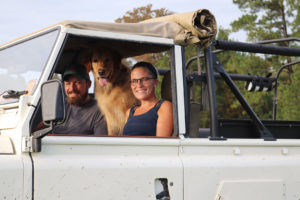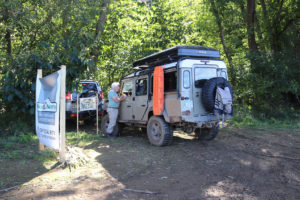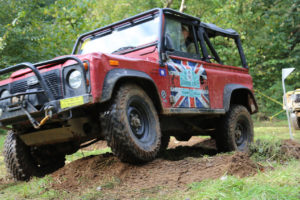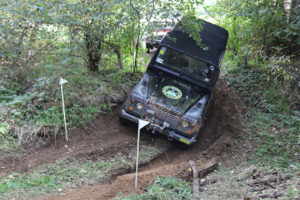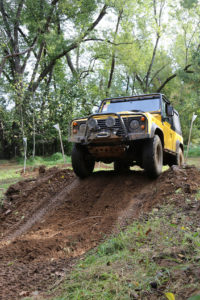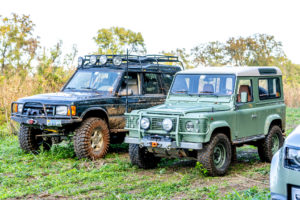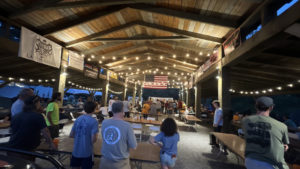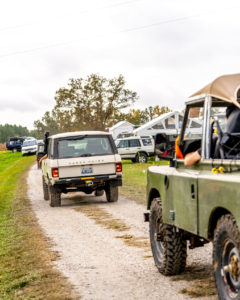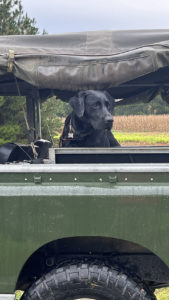Last August, the Rover Owners Association of Virginia (ROAV) opened online registration for its long-running Mid Atlantic Rally (MAR), held annually during the first week of October. It took only 4 hours for enthusiasts to gobble up the 200 available spaces.
Eat your heart out, Taylor Swift!
The event returned to Little George Rod and Gun in Arvonia, VA, and once again, the camping and off-roading brought much acclaim from the nearly 400 participants. Located along two miles of James River frontage and encompassing the evocative Pearl’s Pond, the 1,000-acre mix of forests, hills, fields and farmland attracts game birds and other wildlife as much as the locale appeals to Land Rover enthusiasts. Cass and Tucker Adamson, Richmond, VA, have made the historic family property available to dove hunters, upland pheasant hunters, skeet shooters, family and corporate retreats and — most importantly — Land Rover enthusiasts. The latter holds significance because the Adamsons have a stunning fleet of working ex-MoD Defenders that they enjoy and make available to their hunting and fishing clients.
The extensive trail network, cleared out annually by volunteers, provides endless off-road entertainment, but what if you’ve never driven off-road before? An RTV Trials Course provides the perfect opportunity to learn and practice the skills you’ll want when you go off-road.
RTV (Road Taxed Vehicle) courses have been a staple of Land Rover events in the UK for decades. Like some locales in North America, access to land for off-roading can come at a premium. Whereas off-road trails can require a lot of acreage, a trials course can include, in a much smaller space, the same challenges you’ll encounter on an off-road trail. There’s little risk of vehicle damage, but your ego might be bruised from the effort to succeed.
A trials course relies on a driver’s knowledge of their Land Rover and its capabilities. The driver navigates through a series of narrow gates, each pole numbered consecutively, that require you to twist, turn, climb and descend — without stopping or reversing. Touch a pole, miss a gate, stop and/or reverse and you receive the penalty points indicated on the flag atop the pole. The driver with the lowest point total wins the event. Any Land Rover model can compete, as course rules account for longer-wheelbase vehicles, new wider Land Rovers and differences in steering geometry through the use of a “shunt,” which allows for a stop and a repositioning before entering gates.
Over many years, Rovers North has created and sponsored the RTV Trials Course at the Mid-Atlantic Rally. Last October, Rovers North’s Gene Schubert and I worked with ROAV volunteers to design and construct the course. Gene, who also serves as an instructor at the Land Rover Experience in Manchester, VT, mused about creating trials courses: “I love to be challenged with technical obstacles when I drive off-road,” he said. “It’s like solving a puzzle. So that’s what I consider when designing a trials course. The challenges will include side slopes, suspension articulation mogul fields, ascents, descents, off-camber turns and more. No two trials courses will be the same; however, they all include similar off-road situations.”
The Land Rover off-road driving adage, “as slow as possible, as fast as necessary,” applies to trials courses: Speed plays no part. If you’re driving an open-differential, solid-axle Land Rover (Series, Defender L316, Discovery I-II, Range Rover Classic), you may find that you need a bit of throttle for momentum to prevent a cross-axle situation; newer Land Rovers with traction control and independent suspensions adapt automatically to changes due to obstacles. You might find left foot braking to build torque while keeping a steady throttle will work just fine. (Hint: you’re allowed to walk the course in advance.)
Most trials courses include the following:
Dimensional Challenges
Land Rover has often cited its “command driving position” that assures you can see the front corners of every model. Your next step involves becoming familiar with the rear corners, overall length, width, height and steering geometry. The Range Rover Classic and the Discovery I share a wheelbase of 100 inches and overall lengths from 175–178 inches; the Discovery II stretched out to 185 inches. Even the Defender 110 L663 extends only to a 119-inch wheelbase and an overall length of 187 inches. Squeezing between tight gates (fold in your mirrors) provides you with confidence when navigating off-road obstacles like trees or rock faces. You’ll also want to become familiar with the turning radius of your Land Rover and the center point of your vehicle (generally at B pillar); the same technique that you use to plan your route from gate to gate becomes one you’ll turn to when off-roading between obstacles.
Articulation Challenges
One of the more unsettling off-road situations is when one or two wheels fall suddenly into a deep hole. All Land Rover models have excellent wheel travel, or articulation. For purposes of traction, you want each wheel to touch the ground, so Land Rover builds in the capability for long wheel travel. You don’t want to be startled when the vehicle tilts to one side or the other; when possible, you want to control the speed with which the dangling wheel finally hits the ground.
Side Slope Challenges
Few things are more unnerving to a novice off-roader than traversing a side slope. A tilt of 10–20 degrees makes you feel as though the Land Rover might roll over on its side; the Land Rover Experience Centers instruct and demonstrate on side slopes of 20 degrees. Actually, all Land Rover models can tilt to at least 35 degrees (without weight on the roof). Ideally, you’ll avoid traversing a side slope, but it’s not always possible. Unless you’ve heeled over on a sailboat, the best way to become comfortable with the handling of your Land Rover on a side slope is on a trials course.
Off-Camber Challenges
Off-camber challenges combine features of the side slope and the articulation challenges. A rut, deep hole or mogul on a side slope will likely sneak up on you off road. How you handle the surprise drop and tilt, especially if you need to turn against the tilt angle, will help you when off-roading. Every trials course will try and surprise the driver and/or navigator with a partially or completely hidden off-camber situation. When it’s placed just before a set of gates, the Land Rover will likely wiggle side to side, and might strike a gate.
Ascent, Breakover and Departure Angles
When you approach an uphill obstacle off road, it’s helpful to sense the approach angle, departure angle and breakover angle of your model. A trials course challenge might include a nosedive into a pit, followed by a steep ascent and descent. The breakover angle helps you determine whether your Land Rover will be high centered on an obstacle, such as a rock. Knowing these percentages not just as numbers, but from the feel of experiencing them on a course, will help you decrease the chance of getting stuck.
Route Planning
If you’re off-roading, you’re always looking ahead to plan out the best way to approach your trail conditions – and looking behind to make certain you can see the vehicle behind you. As you drive the trail, you’re likely plotting out how to tackle whatever lies ahead. Trial course rules dictate that you are constantly moving forward, however slowly, calculating how to approach an obstacle without stopping. The descending numbers on each flag, starting at 12 and ending at 1, help guide you – but it’s your task to read the terrain, assess your vehicle’s capabilities and choose the best line to get you through the gates. The trials course experience will help build your understanding of how to tackle challenging terrain.
Constructing the MAR Trials Course
Trials courses will either use the existing topography or create mogul fields, ruts, log or stone obstacles and tight turns to mimic off-road experiences. For this MAR, the organizers had opened five small clearings. Four of the five clearings had natural gullies that would create challenges at the entrance as well as the exits. In addition, we had the good fortune of having Mike McCaig’s talents with a front-end loader to create and shape new obstacles.
Gene and I stared at the otherwise flat, grass-covered ground. We saw that we would have to use tight turns and/or figure eights between gates in order to challenge the drivers and navigators. Access to a chainsaw enabled us to cut and set logs into the ground as obstacles to smooth running; crossing a log, especially at an angle, assures that wheels will leave the ground. With the Adamsons’ permission, we had Mike dig holes and create mounds and moguls in between or at the location of the gates. We chose lines between gates that would force competitors to think through their best paths forward, and at the same time, had sufficient distance between them so we could get vehicles through in a timely manner.
Fortunately, one clearing came with steep moguls and gullies. The placement of the numbered gates could make the course quite challenging, as we used the topography to require passing through gates on side slopes. Once the usual MAR rainstorms occurred, parts of the course became quite difficult — but not dangerous — to tackle.
Gene Schubert recalls, “I received my humble beginnings during the summer of 1998 when I joined a small team of Land Rover driving instructors in Vermont at the Land Rover Experience driving school (the only one, at the time, in North America) This is where my love of building and organizing trials courses would begin. During the next 25 years I would get my training in great events like the G4 challenge, Trek, Trophy and the Peru challenge, and many more private events.”
“Most recently, on the trials course at the Land Rover 75th Diamond Jubilee, I had the pleasure of working with some of my original teachers, Bob Burns, Fred Monsees, Daphne Greene and Jim Swett, to whom I’m forever grateful for their amazing mentorship.”
“I’m especially fond of the trials course at the Mid Atlantic Rally in Virginia. The people are warm and welcoming, and the event gives me a chance to catch up with my Rover community; it’s always like a family reunion. You will always find me in the woods on a trials course as I torture you and challenge you — with a big smile.”
And challenge we did: Bob Steele, Bon Air, VA, a long-time volunteer at the Mid-Atlantic Rally, noted that “this year’s RTV Course was perhaps the best I have seen at MAR. The signage, spectator viewing area and well-designed (some might say evil) course led to a wonderful competition. This was truly the centerpiece of our Rally activities with a full house of 50 competitors and nearly 80 spectators.”
If you’re at a Land Rover event that offers a trials course, take the plunge. Who knows — maybe Taylor Swift will give it a try!
